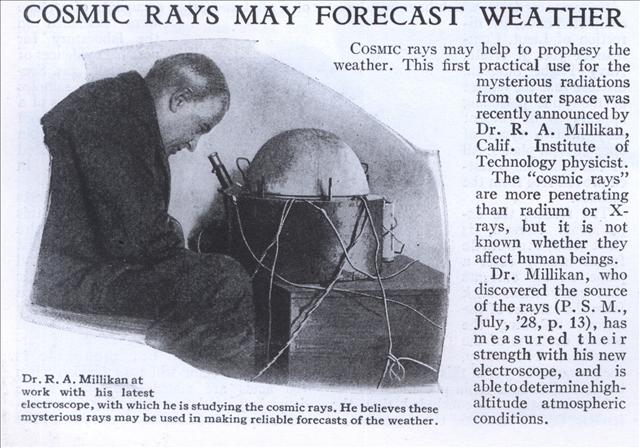|
|
forecast
What happens if we don't ignore astrophysics and model climate based on the environment of the solar system and not just earth. Does it expain the past and can we model climate based on this. Turns out, yes and yes.
|
|
The gist: climate is mostly affected by the high atmospheric clouds
nucleated by hard cosmic rays (galactic radiation). When sun is more
active, the low-mass particles of solar wind create a barrier for the
heavy particles of the galactic cosmic rays. This causes fewer clouds,
which allows more sunlight to reach the surface, which warms the
climate. During the low solar activity periods, solar wind is weak, and
heavy particles cause nucleation and cloud formation in the high
atmosphere, which shades the earth and causes Maunder's minimum and the
like.
|
|
"Simulating what could happen in the atmosphere, the DTU’s SKY2 experiment shows molecular clusters (red dots) failing to grow enough to provide significant numbers of ”cloud condensation nuclei” (CCN) of more than 50 nanometres in diameter. This is what existing theories predict. But when the air in the chamber is exposed to ionizing rays that simulate the effect of cosmic rays, the clusters (blue dots) grow much more vigorously to the sizes suitable for helping water droplets to form and make clouds. (A nanometre is a millionth of a millimetre.)"
|
Jasper Kirkby: The CLOUD experiment at CERN
The cosmic ray theory of Svensmark et al postulates that small changes in solar activity can have amplified effects upon the climate by influencing galactic cosmic rays and cloud formation. Scientists at CERN -the European Laboratory for Particle Physics have been studying this theory in the laboratory for the past several years, and according to Nigel Calder's blog (former chief editor of New Scientist), the experiment is showing that cosmic rays have a strong influence on aerosol (cloud) formation.
|
Temperature of earths core measured in 2013
Scientists have determined that the core of the Earth is 6,000 degrees Celsius; 1,000 degrees hotter than previously thought. This new data fits the model that says there must be a temperature difference of 1,500 degrees Celsius to generate a magnetic field. The previous temperature did not fit those parameters.
|
|
Fluctuating climate is a hallmark of Earth, and the present greenhouse effect is by far the only force affecting today's climate. On a larger scale the Earth's climate is also strongly affected by how the Earth orbits around the sun; this is called orbital forcing of climate change. These changes happen over thousands of years and they bring ice ages and warming periods.
Now researchers from University of Southern Denmark, China National Petroleum Corporation and others have looked deep into Earth's history and can reveal that orbital forcing of climate change contributed to shaping the Earth's climate 1.4 billion years ago.
|
Gag order over CERN experiment
CERN is doing an experiment to test how much the cosmic rays are a component of climate. There's a gag order on the results of the experiment.
|
Top Indian space boffin beams down climate shocker
2011 - India's leading space physicist believes cosmic rays affect the Earth's climate far more than previously thought.
"The report was commissioned by Indian environment minister Jairam Ramesh, who has described the manmade global warming hypothesis as a "religion".
"We’re not denying the contribution of greenhouse gases — we’re only trying to expand the scientific debate to look at some non-greenhouse gas factors that may also influence global warming," Ramesh told the Telegraph of India"
|
|
Suggests that cosmic rays are the overarching force behind climate change.
|
|
|
|
Earth and Mars are both coming out of an ice age
Mars is coming out of an ice age, study shows
The Martian ice began its retreat about 370,000 years ago, radar images suggest
Thomson Reuters Posted: May 26, 2016 3:06 PM ET
|
Solar Activity and Climate, 2012
Hiroko Miyahara, The University of Tokyo
|
Solar Variability and Terrestrial Climate
"Of particular importance is the sun's extreme ultraviolet (EUV) radiation, which peaks during the years around solar maximum. Within the relatively narrow band of EUV wavelengths, the sun’s output varies not by a minuscule 0.1%, but by whopping factors of 10 or more. This can strongly affect the chemistry and thermal structure of the upper atmosphere."
|
|
Where cosmic rays come from.
"And compared with the temperature variations seen on short timescales as a consequence of the Sun's influence on the influx of cosmic rays, the heating and cooling of the Earth due to cosmic rays varying with the prevailing supernova rate have been far larger."
|
|
Lawrence Solomon: Science getting settled
New, convincing evidence indicates global warming is caused by cosmic rays and the sun — not humans
|
New paper finds strong evidence the Sun has controlled climate over the past 11,000 years, not CO2
A paper published today in Journal of Atmospheric and Solar-Terrestrial Physics finds a "strong and stable correlation" between the millennial variations in sunspots and the temperature in Antarctica over the past 11,000 years. In stark contrast,...
|
Solar history may have links with Earth's climate
The data suggests that changing solar activity is influencing in some way the global climate.
|
David Archibald Global Warming & Sunspots explained
The relationship between sunspots and global warming, from 500 years of data, explained. Made in 2007, this predicts extreme cold in 2013/2014 winters.
|
|
|



